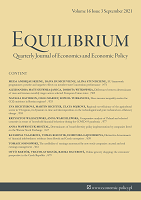Enterprise ownership patterns in the least developed districts of Slovakia
Enterprise ownership patterns in the least developed districts of Slovakia
Author(s): Marek Csabay, Zuzana Vincúrová, Milan Stoch, Beáta StehlíkováSubject(s): Business Economy / Management, Regional Geography, Economic development
Published by: Instytut Badań Gospodarczych
Keywords: regional business structure; cluster analysis; spatial autocorrelation; ownership types; least developed districts;
Summary/Abstract: Research background: The literature overview shows a blank space regarding the effects of ownership on the determination of enterprises' spatial distribution. Various papers identify differences between determinants of the spatial distribution of foreign direct investments, exporters in foreign ownership, and domestically owned exporters; however, they mostly agree on the role of big cities, economic centres, and state of infrastructure as well as historical patterns. Purpose of the article: The article focuses on the spatial distribution analysis of enterprise units from their owner's perspective on the empirical evidence from all 79 districts of the Slovak Republic. Special attention is given to the category of the least developed districts. Methods: Within the presented article, the authors investigate the characteristics of the regional spatial distribution of business entities concerning standard ownership categories using the cluster analysis. The presented approach is twofold: firstly, the authors investigate the share of individual ownership types on the district level, and secondly, the number of enterprises by ownership categories is adjusted to 100,000 inhabitants. Cluster analysis and methods of spatial statistics are applied in both approaches. Findings & value added: The main results show a relation between the district's inclusion into the group of the least developed districts and enterprise ownership characteristics in these districts mainly through the relative underrepresentation of the secluded inland, foreign and international types of ownership, as well as their geographical clustering. The results of the presented research can be used in policy-making targeting business activity in underdeveloped districts. At the same time, the results provide basis for limited theoretical generalisations based on a single-country case study with regard to principles of business ownership structures development.
Journal: Equilibrium. Quarterly Journal of Economics and Economic Policy
- Issue Year: 16/2021
- Issue No: 4
- Page Range: 807-838
- Page Count: 32
- Language: English

